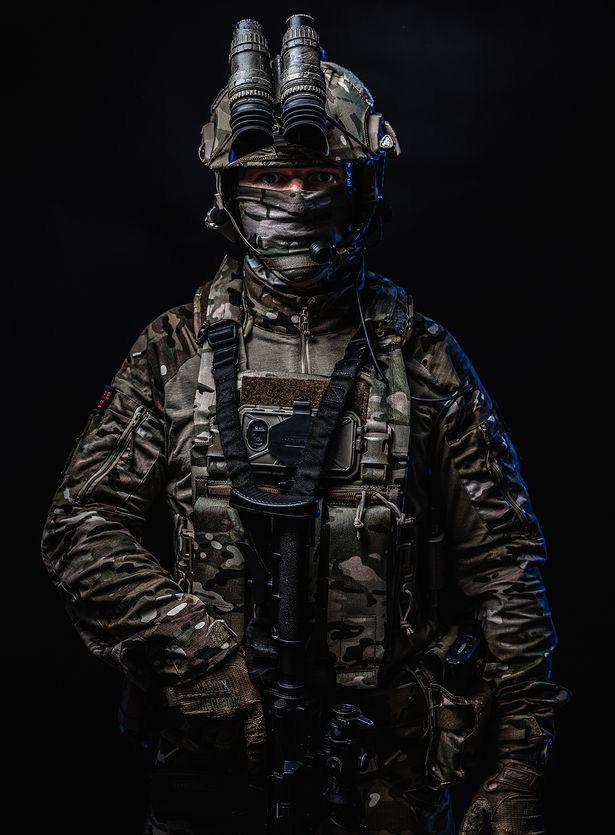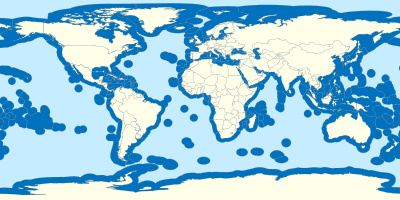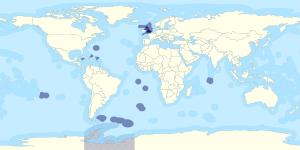Mebbe you can stop ooing and ahhing over LCF buttons and bows long enough to read what the troopies are supposed to be doing in their new gear.  ;D ;D ;D
You might be interested in what and where.
https://www.telegraph.co.uk/news/2020/06/26/uks-future-commando-force-radical-lethal-new-unit-fight-threats/
Apparently the force is to be built around the three Bay Class LSDAs (bet they wish they still had the one they sold to the Aussies). Just a reminder they are 16,000 tonne flat decks with a well deck and no hangar, built to civvy standards, with a civvy crew of 70 (Royal Fleet Auxiliary) and capable of carrying 1,150 linear metres (vehicles), 200 tons or 24 TEU (cargo) and 356 troops (700 at a squeeze)
Here outfitted with a bunch of drones and stuff for mine clearance
UK's Future Commando Force: a radical and 'lethal' new unit to fight threats across the globe
Two new Littoral Response Groups - one east of Suez,
one in the High North - will hold hundreds of Commandos at immediate notice to move
By
Dominic Nicholls,
DEFENCE AND SECURITY CORRESPONDENT
26 June 2021 • 11:00pm
Britain’s Commando forces are to undergo a radical transformation to face future threats across the globe, the Royal Navy has announced.
The days of British troops charging across enemy held beaches are, hopefully, over. However, complex and technically advanced threats from adversaries have demanded a new way of projecting force.
As modern weapon systems can hit ships hundreds of miles out from an objective, just getting to the fight is now a problem in itself.
Major General Matthew Holmes, the Commandant General of the Royal Marines (CGRM), says the Future Commando Force will be a more “lethal, survivable and sustained” amphibious capability.
A persistent forward presence based on ships seeks to offer global access and “pose greater dilemmas to our adversaries,” General Holmes says.
Two Littoral Response Groups (LRG), each of a few hundred commandos and supporting elements, will deploy on roughly six-month cycles to respond to crises ranging from humanitarian disaster to conventional warfare.Â
It is envisaged one LRG will be permanently east of Suez, with the Royal Navy facility in Bahrain acting as a staging post.
The second Group will focus on Nato’s northern flank, working closely with Norwegian amphibious forces, and the Mediterranean.
The three Bay-Class Landing Ship Dock Auxiliary ships, crewed by the Royal Fleet Auxiliary, will be the likely hosts, initially at least, with additional medical and aviation facilities developed in the near future.
General Holmes says there will be “tangible differences” in how Britain’s commando forces operate from next year.
Initial developmental work will take place through 40 Commando, based in Taunton, Somerset.
Royal Marines want to be forward deployed on operations, General Holmes says, “unequivocally”.
The Future Commando Force concept is being developed just as the US Marine Corps wrestles with similar ideas.
In �?Force Design 2030’, released in March this year, the Commandant of the US Marine Corps is similarly seeking to adapt his force for future threats with an emphasis on the Indo-Pacific region; longhand for China.
Introducing the work, General David Berger said “modest and incremental improvements to our existing force structure and legacy capabilities [will] be insufficient to overcome evolving threat capabilities”.
He has directed that: “The Marine Corps must be able to fight at sea, from the sea, and from the land to the sea; operate and persist within range of adversary long-range fires... Achieving this end state requires a force that can create the virtues of mass without the vulnerabilities of concentration, thanks to mobile and low-signature sensors and weapons.”
Greater use of armed unmanned surveillance systems, long-range precision weapons and �?bubbles’ of secure communications are expected to be at the core of the force.
One of the first actions was for the USMC to get rid of its seven squadrons of main battle tanks, deemed too cumbersome and logistically demanding for the lighter and more agile force General Berger demands.
The Future Commando Force concept does not seek to copy the USMC model, but respond to the shared vision of the threat through an appropriately British financial and political lens.
Colonel Mark Totten, Programme Director of the Future Commando Force, said the programme had two main drivers.
The first is the increased conventional threat posed by technically sophisticated weapons, particularly when matched with artificial intelligence.
Advances in defensive systems mean it is now easier to find, identify and engage military forces with much greater lethality and at much greater range. These so-called Anti-Access/Area Denial capabilities (known as A2AD in military jargon) will make it much harder to get into an area of operations, let alone operate in comparative safety once there. As theatre-entry troops, Commando forces need to address this threat.
“If we don’t, the conventional aspect of our deterrence model will probably be less effective,” Colonel Totten says.
The threat to maritime forces has increased significantly in recent years.
States such as China have made technological and operational advances in areas such as long range precision missiles that can pose unprecedented threats to ships hundreds of miles away from their objectives.Â
Even non-state actors with reasonably low grade coastal defence munitions can pose maritime task groups problems.
One such place is the Bab al-Mandab strait between Yemen and the Horn of Africa, a vital choke point through which 4.8 million barrels of oil passed every day in 2016. “It’s a widespread problem,” Colonel Totten says. “If we are to make a contribution to Nato we will have to address it.”
The second driver for the Future Commando Force is the more aggressive use of difficult to identify military forces, combined with economic and diplomatic activity and disinformation: commonly referred to as sub-threshold (of war), hybrid or ďż˝?grey zone’ activities.Â
This area between declared warfare and state competition is a sophisticated and complex operating environment. It is important for political decision makers to have a broad range of military options to complement actions by the intelligence agencies and special forces. The Future Commando Force is billed as a possible high-end conventional contribution to this demand.
The Royal Marines hope the Future Commando Force will also break the “get ready to be ready” model of force generation.
Colonel Totten says Commando forces cannot just “wait for something to happen” before deploying. The aim is to get troops forward where they’re needed, working alongside partner nations.
“We can provide more problem sets to an adversary as a crisis builds,” he says.
He eschews the suggestion such a posture would, in itself, be a provocative act.
The forward deployed Littoral Response Groups, numbering in the low hundreds of Royal Marines and supporting elements, would fit into an already existing network of forward defence presence, he says.
“It would not be introducing a totally new dynamic, which could be escalatory.
“It means an adversary has to track something more than it does today. It’s very easy to track a Task Group deploying from Devonport.”
A persistent presence forward provides an additional surveillance problem for any would-be enemy, he says. It would also focus attention in a way talk of preparing forces in the UK might not.
Colonel Totten held out the prospect of legacy platforms being retired to enable new capabilities to be brought in. Such wider discussions will be included in the government’s Integrated Review of Foreign, Defence and Security policy, due to start later this year.
Nick Childs of the International Institute for Strategic Studies says developing the Future Commando Force is a recognition that Britain’s amphibious capability needed updating. “The status quo was not going to be the answer to the future,” he says.
Repeated Defence cuts over the last decade have hit maritime forces hard and have left Britain’s amphibious capabilities vulnerable against the opposition they are likely to face in the future, Mr Childs believes.
He says the USMC work is leading the way for Western militaries in general when it comes to “sacrificing sacred cows” (such as their tanks) so as to adapt to modern threats.
“The Commandant of the US Marine Corps has grabbed a lot of attention and won a lot of plaudits for being prepared to be radical,” he says.
The ambition for the Future Commando Force to be more flexible, dispersed and available is probably right, he believes, although some - hinting at China - “will take a less beneficial view of it”.
However, he questions whether the plan will work without more investment in maritime capabilities.
“My concerns are that in order to deliver the kind of effects [CGRM] is talking about, there is going to have to be quite a lot of investment in new capabilities.
“It’s not going to be the classic assault across the beach anymore, it’s going to be from more stand-off ranges around 150 nautical miles, delivered onto land. In order to be able to be really effective [they] will have to invest in more capabilities.”
Mr Childs questions whether the Future Commando Force will have enough resources to be able to operate assault forces at a scale over and above traditional raiding parties without additional investment. Using existing capabilities might take them away from other tasks, adding to the resource burden.
“How do you balance using the aircraft carriers for the Carrier Strike capability but also for operating in an amphibious role?” he wonders.Â
“There are only three Landing Ship Dock Auxiliary and they are probably the most in-demand platforms in the naval service at the moment. What is going to happen to the Landing Platform Docks (HMS Albion and HMS Bulwark), only one of which is running at any one time? Where are we with the Littoral Strike Ship idea?”
The USMC and US Navy are considering getting rid of some of their classic naval platforms in favour of smaller, faster and more agile vessels for the amphibious role.
General Holmes was unable to discuss future investments ahead of the Integrated Review.
However, he said: “We’ve got what we need at the moment in order to demonstrate the concept.
"I’m confident that by demonstrating what the new concept offers to Defence it will get the requisite support.”
Too bad we couldn't figure out something similar with some light troops, AOPS and maybe an Asterix or two. Beyond Canadians I guess. ;D ;D ;DÂ














